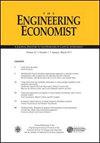利用经济相互依赖、基于主体和贝叶斯模型评估内河航道破坏的综合方法
IF 1.2
4区 经济学
Q4 BUSINESS
引用次数: 0
摘要
摘要:美国内河航道在国内经济中发挥着至关重要的作用,但极端天气事件,特别是洪水,不断威胁着它们的运行。在这里,我们开发了一种数据驱动的方法来分析内陆水道洪水关闭造成的经济风险,该方法结合了基于代理的、经济相互依存的和贝叶斯模型。我们通过评估密西西比河上游各种洪水破坏的经济影响来展示我们的框架,并确定位于河口附近的公共运营,抗洪港口可以改变运输路线并减轻该地区的生产损失的案例。我们发现,伊利诺伊州、路易斯安那州、明尼苏达州和密苏里州是受洪水破坏影响最大的州,农业和化学制造业是受影响最大的行业。然而,在汛期超过30年的洪水期间,抗洪港口在减轻该地区损失方面具有成本效益。我们的方法可以很容易地扩展到其他危险和内陆水道的部分。本文章由计算机程序翻译,如有差异,请以英文原文为准。
An integrated approach to evaluating inland waterway disruptions using economic interdependence, agent-based, and Bayesian models
Abstract The U.S. inland waterways play a vital role in the domestic economy, but extreme weather events, especially floods, perennially threaten to disrupt their operations. Here, we develop a data-driven approach to analyzing economic risks due to flood closures along the inland waterways that combines agent-based, economic interdependence, and Bayesian modeling. We demonstrate our framework by evaluating economic impacts of various flood disruptions along the Upper Mississippi River and determining cases where a publicly operated, flood-resilient port located near the mouth of the river can reroute shipments and mitigate production losses for the region. We find that Illinois, Louisiana, Minnesota, and Missouri are the states that suffer the most production losses from flood disruptions and that agriculture and chemical manufacturing are the most impacted industries. However, during floods whose return periods exceed 30-years, the flood resilient port becomes cost-effective in mitigating losses for the region. Our methodology can be easily extended to other hazards and sections of the inland waterways.
求助全文
通过发布文献求助,成功后即可免费获取论文全文。
去求助
来源期刊

Engineering Economist
ENGINEERING, INDUSTRIAL-OPERATIONS RESEARCH & MANAGEMENT SCIENCE
CiteScore
2.00
自引率
0.00%
发文量
14
审稿时长
>12 weeks
期刊介绍:
The Engineering Economist is a refereed journal published jointly by the Engineering Economy Division of the American Society of Engineering Education (ASEE) and the Institute of Industrial and Systems Engineers (IISE). The journal publishes articles, case studies, surveys, and book and software reviews that represent original research, current practice, and teaching involving problems of capital investment.
The journal seeks submissions in a number of areas, including, but not limited to: capital investment analysis, financial risk management, cost estimation and accounting, cost of capital, design economics, economic decision analysis, engineering economy education, research and development, and the analysis of public policy when it is relevant to the economic investment decisions made by engineers and technology managers.
 求助内容:
求助内容: 应助结果提醒方式:
应助结果提醒方式:


